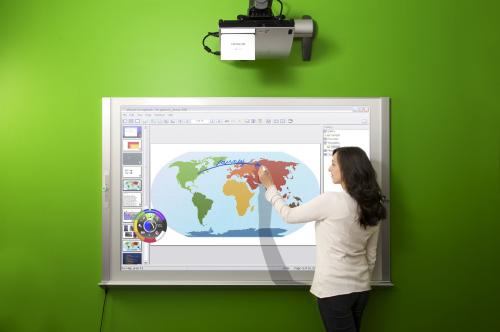|
|
|
2 . Multimedia (多媒体) |
|
|
|
图7.7 多媒体 |
|
2.1 What is multimedia? Multimedia systems may consist of tradictional media in combination or they may incorporate the computer as a display device for text,picture,graphic,sound,and video.The term multimedia goes back to the 1950s and describes early attempts to combine various still and motion media for heightened educational effect.Multimedia involves more than simply integrating these formats into a structured program in which each element complements the others so that the whole is greater than the sum of the parts.Today examples of multimedia in education and training include slides with synchronized audiotapes,videotapes,CD-ROMs,DVD,the World Wide Web,and virtual reality. Multimedia addresses different learnin styles.Auditory learners,visual learners,and tactile learners all benefit from multimedia’s varied presentation forms.The redundancy of print,sound,visuals,and motion media allows learners to choose for themselves the most meaningful sensory mode.When you, the instructor,have a clear sense of objectives and the necessary student ptactice,you can decide what media will best facilitate the learning and how best to deliver it. |
|
2.2 The Multimedia Kits (多媒体教学包) (1) What is the Multimedia Kits The multimedia kits is a collection of teaching/learning materials involving more than one type of medium and organized around a single topic.Kits may include CD-ROMs,slides audiotapes,videotapes,still pictures,study prints,overhead transparencies,maps,worksheets,charts,graphs,booklets,real objects,and modles. |
|
|
|
图7.8 多媒体教学包 |
|
(2) Advantages
|
|
(3) Limitations
|
|
(4) Integration Multimedia kits are particularly well suited to content for which discovery learning is preferred.You can pose questions to guide learners’ exploration and arrival at conclusions.Science topics are well suited to this approch. 例如,一套磁力学教学包中包含各种此贴、铁屑以及几块金属,这些金属有的能被磁铁吸引,有的不能。在数学课上,一个“测量”教学包中包含一根折尺,一个不同物体的测量指南,以及家里和学校不同的测量尺寸说明。 |
|
2.3 Hypermedia (超媒体) |
|
|
|
图7.9 超媒体组织 |
|
(1) What is the Hypermedia ? Hypermedia was coined by Nelson in 1974 to describe “nonsequential documents”composed of text,audio,and visual information stored in a computer,with the computer being used to link and annotate related chunks of information into larger networks,or webs.The goal of hypertext is to immerse users in a richly textured information environment,one in which words,sounds,and still and motion images can be connected in diverse ways.Enthusiasts feel that the characteristics of hypertext parallel the associative properties of the mind,thereby making the construction of one’s own web a creative educational activity. |
|
(2) Advantages
|
|
(3) Limitations
|
|
(4) Integration |
|
|
|
图7.10 超媒体信息集示例 |
|
Hypermedia can be developed and used on the same computer systems that are commonly found in schools.They are applied in all areas of the curriculum,for any learning goals that are suited to individual or small groap exploration of a body of information.Hypermedia programs are available as off-the-shelf courseware;teachers can create them to fit unique local needs;or students can create them as a way of organizing and synthesizing their research on a topic of interest. |
|
2.4 Interactive Media (交互媒体) (1) What is the interactivemedia ? |
|
|
|
图7.11 交互媒体 |
|
Computer-based Interactivemedia creates a multimedia learning environmenr that capitalizes on the features of both video and coomputer-assisted instruction.It is an instructional delivery system in which recorded visuals,sound,and video materials are presented under computer control to viewers who not noly see and hear the pictures and sounds but also make active reponses,with those responses affecting the pace and sequence of the presentation. |
|
(2) Advantages
|
|
(3) Limitations
|
|
(4) Integration Interacive media systems are currently being used in a variety of instructional applications,from teaching scientific phenomena to teaching special education students to tell time.The programs can challenge a small group of gifted students or provide remedial instruction for students who might be having difficulty with particular concepts.Individuals as well as small groups can use interactive media programs.Interactive media may also be used for large-group instruction. |
|
2.5 Virtual Reality (虚拟现实) |
|
|
|
图7.12 虚拟现实 |
|
(1) What is the Virtual Reality ? Virtual Reality is one of the newest appliacations of computer-based technologies.There are actually several levels of virtual reality,from complex ,meaning you are completely immersed inside the virtual environment,to augmented, or partially immersed,to desktop level,meaning you are using your computer to look into a virtual “window.” |
|
(2) Advantages
|
|
(3) Limitations
|
|
(4) Integration The potential of this type of technology in the area of special education is exciting,providing safe yet detailed lifelike learning experience for students with learning problems has promise.As virtual reality tools will be able to explore ways of using this type of technology in learning,it will become possible for them to create their own unique environments.These typespf experiences will add to the dimensions of the classroom in exciting ways. |
|
2.6 Expert Systerms (专家系统) The Expert systerm i s a software package that allows the collective wisdom of experts in a given field to be brought to bear on a problem.One of the first such systems to be developed was MYCIN,a progam that helps train doctors to make accurate diagnoses o infectious diseases on the basis of tests and patient information fed into the computer.Expert systems are rapidly making their way into education. |
Unit 7-知识点二:多媒体
Top Block Position
Unit 7-知识点二:多媒体
完了要件
最終更新日時: 2018年 04月 16日(月曜日) 18:56
Bottom Block Position




